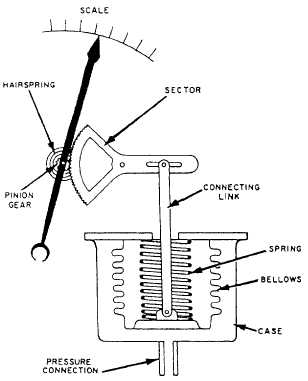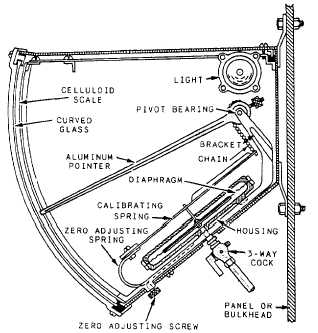Figure 11-7.–Bellows gauge.
the pressure difference, rather than either
actual pressures indicated by the pointer.
BELLOWS GAUGE
of the two
A bellows gauge contains an elastic element that is
a convoluted unit that expands and contracts axially with
changes in pressure. The pressure to be measured can
be applied to the outside or inside of the bellows.
However, in practice, most bellows measuring devices
have the pressure applied to the outside of the bellows
(fig. 11-7). Like Bourdon-tube elements, the elastic
elements in bellows gauges are made of brass, phosphor
bronze, stainless steel, beryllium-copper, or other metal
that is suitable for the intended purpose of the gauge.
Most bellows gauges are spring-loaded; that is, a
spring opposes the bellows, thus preventing full
expansion of the bellows. Limiting the expansion of the
bellows in this way protects the bellows and prolongs
its life. In a spring-loaded bellows element, the
deflection is the result of the force acting on the bellows
and the opposing force of the spring.
Although some bellows instruments can be
designed for measuring pressures up to 800 psig, their
primary application aboard ship is in the measurement
of low pressures or small pressure differentials.
Figure 11-8.—Diaphragm gauge.
Many differential pressure gauges are of the bellows
type. In some designs, one pressure is applied to the
inside of the bellows, and the other pressure is applied
to the outside. In other designs, a differential pressure
reading is obtained by opposing two bellows in a single
case.
Bellows elements are used in various applications
where the pressure-sensitive device must be powerful
enough to operate not only the indicating pointer but also
some type of recording device.
DIAPHRAGM GAUGES
Diaphragm gauges are very sensitive and give
reliable indication of small differences in pressure.
Diaphragm gauges are generally used to measure air
pressure in the space between the inner and outer boiler
casings.
Figure 11-8 shows the indicating mechanism of a
diaphragm gauge. This mechanism consists of a tough,
pliable, neoprene rubber membrane connected to a
metal spring that is attached by a simple linkage system
to the gauge pointer.
One side of the diaphragm is exposed to the pressure
being measured, while the other side is exposed to the
atmosphere. When pressure is applied to the diaphragm,
it moves and, through a linkage system, moves the
pointer to a higher reading on the dial. When the
11-4




